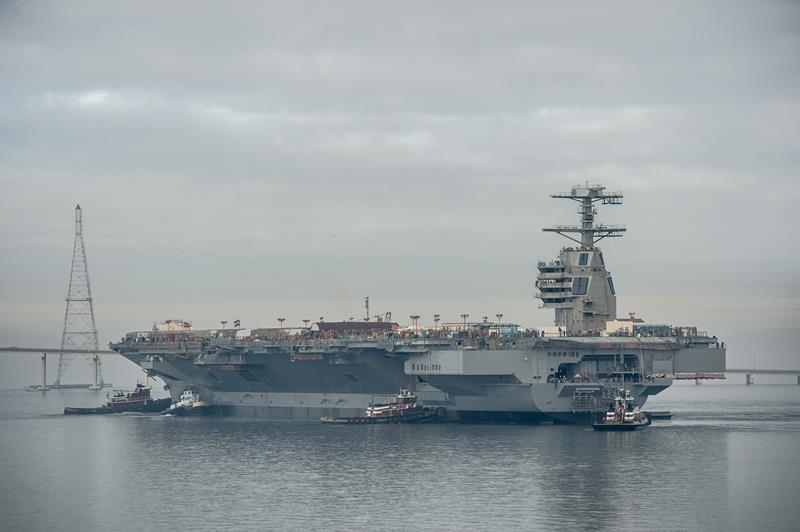The lead ship in the Ford-class , the future USS Gerald R. Ford (CVN-78), was launched at Newport News Shipbuilding in November 2013. Photo by Chris Oxley
By Tony Capaccio
(Bloomberg) — Top Pentagon officials have ordered the Navy to conduct shock tests at sea for its new aircraft carrier over objections from the service, which says the requirement may delay deployment by as long as six months.
Navy officials have argued that postponing full shock testing of the $12.9 billion USS Gerald R. Ford, the costliest U.S. warship, until as late as 2025 is justified because its components are being fully tested, it’s designed to be hardened against combat shocks and it’s being evaluated through modeling and simulation.
Deputy Defense Secretary Robert Work, the Defense Department’s No. 2 civilian official, decided otherwise and directed that the tests be completed before deployment of the ship designated CVN 78 and built by Huntington Ingalls Industries Inc., according to a memo sent to the Navy and a spokeswoman for the service.
The test “will be conducted to ensure the survivability of the CVN 78 design is understood prior to beginning operational deployments,” Frank Kendall, the undersecretary for acquisition, wrote on Aug. 7 to Navy Secretary Ray Mabus, conveying Work’s decision.
In a shock trial, underwater charges are set off to assess how well a ship can withstand them. A crew is on board, and the test isn’t intended to damage equipment. The results are used to judge vulnerabilities and design changes that may be needed.
Pentagon Debate
The decision ordering the testing by Work, a former Marine who served as Navy undersecretary, is part of continuing debate inside the Pentagon over testing the Ford carrier. It has pitted the Navy against the Pentagon’s director of combat testing and at least three other civilian officials who all pushed for the test.
The chief tester, Michael Gilmore, has said that if the carrier performs as the Navy maintains, the process should take no more than three months.
More broadly, the debate reflects tensions between the military services, which want to field new weapons systems as soon as possible, and testing specialists who have gained clout since Congress created the office of combat testing in 1983, the U.S. Government Accountability Office said in a June report.
Conducting tests on the Ford before deployment would delay the return to an 11-carrier fleet, the number mandated by Congress, the Navy has said.
The Navy has operated with 10 carriers with the retirement of the USS Enterprise in 2012. Extended deployments of the remaining ships have placed stress on crews, the service has said.
Potential Vulnerabilities
Pentagon leaders considered the test’s timing and implications and its impact on the deployment schedule, Kendall’s spokeswoman, Maureen Schumann, said in an e-mail.
After discussions with the Navy, the leaders “concluded that impacts on operational deployments did not outweigh the utility of obtaining information about potential vulnerabilities, which could be revealed through testing,” she said.
Work made “the right decision,” Senate Armed Services Committee Chairman John McCain said in an e-mail.
McCain, an Arizona Republican, has pressed the Navy to do the testing that he said “will mitigate the risks of integrating several new technologies, improve the design of future carriers, and, most importantly, increase” the vessel’s survivability and the “ability of the crew to survive battle damage.”
Navy Notified
Commander Thurraya Kent, a Navy acquisition spokeswoman, said in an e-mail that the service “has been notified of the decision” and “will move forward as directed.”
James Thomsen, who was the Navy’s principal civilian deputy for acquisition, wrote Kendall on May 20 extolling the Ford’s progress as validating the service’s rationale for a test delay.
“These improvements significantly reduced the risk of mission-critical failures in a combat shock environment but don’t eliminate them completely,” Thomsen wrote. “While there is some risk of deploying in advance of the shock trial, the Navy considers that this is low-risk and acceptable.”
In its report on the defense authorization bill for fiscal 2016, H.R. 1735, the Senate Armed Services Committee said the Ford’s new catapult, arresting system and radar “as well as a reliance on electricity rather than steam to power key systems” mean “there continues to be a great deal of risk in this program.”
The Senate version of the bill, now in negotiation in a House-Senate conference committee, would add $79 million for the shock test and a requirement for the Navy to certify that it will be performed no later than Sept. 30, 2017.
It also would hold up $100 million in procurement spending on the second carrier in the new class, the USS John F. Kennedy, until the Navy submits its certifications. The House version doesn’t have those provisions.
The Senate defense appropriations subcommittee, unlike its House counterpart, also would provide the $79 million for testing in its proposed fiscal 2016 spending bill.
©2015 Bloomberg News

 Join The Club
Join The Club











